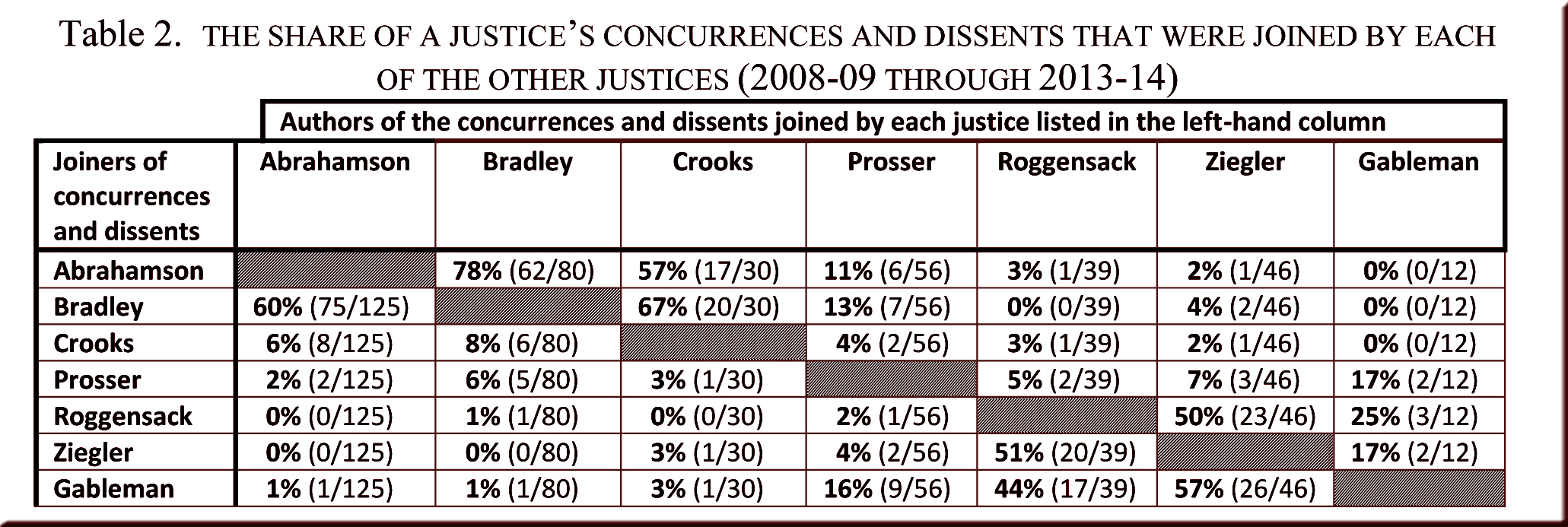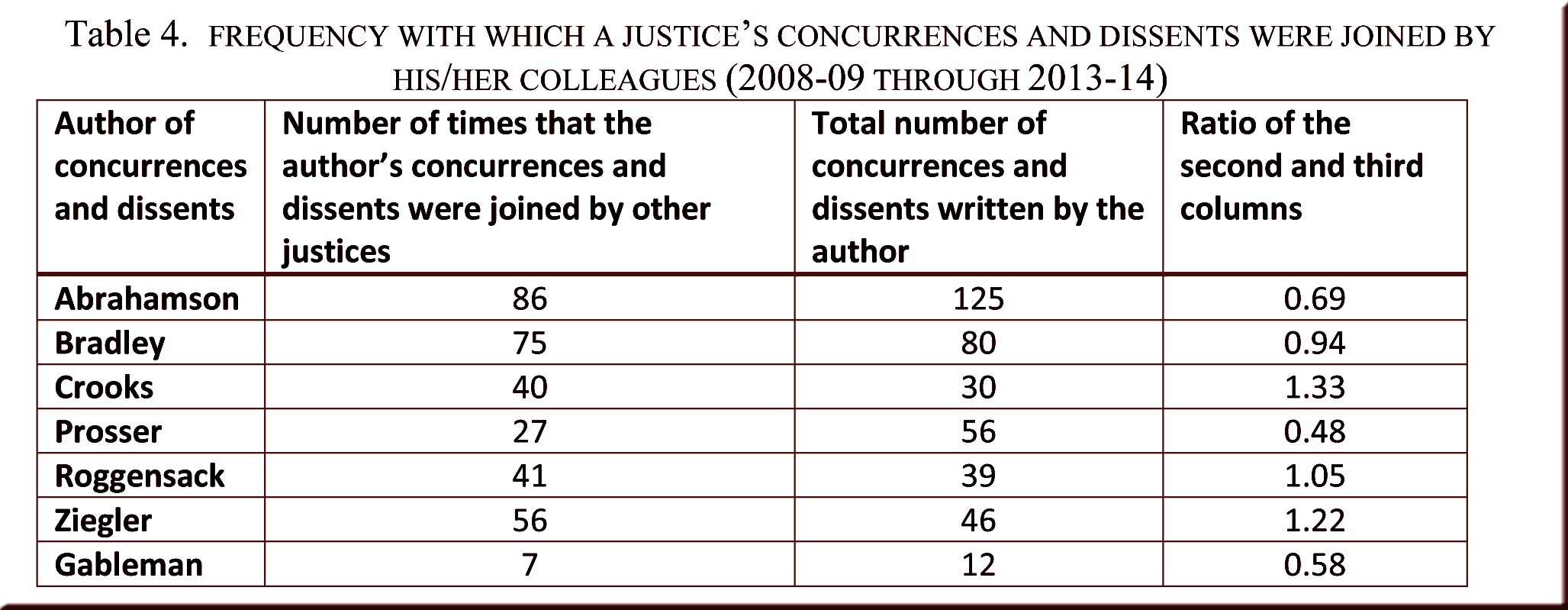A reader (who prefers not to be acknowledged) suggested the title’s question, prompting me to cast a net for pertinent information contained in the decisions published on the court system’s website. We’ll focus on the six terms during which the current group of seven justices have served together (2008-09 through 2013-14) and pose the anonymous reader’s question for each justice individually—that is, how frequently did each justice join concurrences and dissents written by each of his or her colleagues?
The initial response is displayed in Table 1, which should be read as follows. The justices in the column at the left end of the table are those who joined concurrences or dissents, while the row of names across the top of the table lists the authors of the opinions joined by justices in the column at the left. For instance, beginning with Justice Abrahamson at the top of the left-hand column and following her row across the table, we see that she joined Justice Bradley’s concurrences and dissents 62 times, and on 17 occasions she joined those written by Justice Crooks. Continuing along the row, we find that she joined six of Justice Prosser’s concurrences/dissents, one written by Justice Roggensack, one by Justice Ziegler, and none by Justice Gableman.[1]
Table 1 suggests a number of points noted in previous SCOWstats posts. The fact that Justices Abrahamson and Bradley wrote far more concurrences and dissents than the other five justices is readily discernible, for example, as is the rarity of agreement between the two “liberal” justices (Abrahamson and Bradley) on the one hand and the three most “conservative” justices (Roggensack, Ziegler, and Gableman) on the other.
As it turned out, the two “liberals” joined only four of the 97 concurrences/dissents written by the three “conservatives,” while the three “conservatives” joined only three of the 205 concurrences/dissents written by the two “liberals.” Exploring such interactions in more detail, Table 2 specifies how many of each justice’s opinions were joined by any other justice. As an illustration of how to interpret the information, take Justice Prosser’s column in the middle of the table. The column indicates that Justice Prosser wrote 56 concurrences/dissents and that Justice Abrahamson joined 6 of these (or 11%). Justice Bradley joined 7 of the 56 (13%), Justice Crooks 2 (4%), Justice Roggensack 1 (2%), Justice Ziegler 2 (4%), and Justice Gableman 9 (16%).
One aspect of the first table that might raise an eyebrow is the information for Justice Gableman. Readers would expect Justices Abrahamson and Bradley to join each other’s opinions routinely, and they would also expect frequent mutual endorsement between Justices Roggensack and Ziegler—all of which is evident in the table’s figures. But what happened with Justice Gableman? Although jaws might not drop upon discovering that Justice Crooks (to say nothing of Justices Abrahamson and Bradley) declined to join a single one of Justice Gableman’s separate opinions, even his closest allies on the bench added their names to only a handful of concurrences and dissents credited to him.
This gap between Justice Gableman and his colleagues is displayed more clearly in Table 3, which provides totals for the columns and rows in Table 1. Here we see that although Justice Gableman joined other justices’ concurrences/dissents in large number—55 times, slightly more than the total for Justices Roggensack and Ziegler combined—his six colleagues, including his fellow conservatives, joined his own opinions only seven times.
I’m not certain how to account for Justice Gableman’s unusually high rate of joining other justices’ opinions—far above the figures for the other conservatives (but not the two liberals). Regarding the extremely small number of instances where other justices joined his own concurrences/dissents, much of the explanation lies in the fact that Justice Gableman rarely wrote such opinions. As noted in Table 4 (and Table 2), he submitted only 12 concurrences/dissents over the entire period, an average of only two per term, leaving other justices few opportunities to associate themselves with his analysis if they were so inclined.
To compensate for the small number of concurrences/dissents written by Justice Gableman, Table 4 includes a column displaying the ratio of column 2 (the number of times that a justice’s concurrences/dissents were joined by other justices) over column 3 (the total number of concurrences/dissents written by the justice in question). This should help adjust for the fact that the hefty number of “joiners” linked to Justices Abrahamson and Bradley owes much to the unusually large volume of concurrences and dissents that they authored.
Bear in mind when interpreting the ratios in Table 4 that a figure of “1” would result if each of an author’s concurrences/dissents were joined by one other member of the court. Justices Bradley (0.94) and Roggensack (1.05) were extremely close to this mark, while Justices Ziegler (1.22) and especially Crooks (1.33) were well above it—suggesting that a third of Justice Crooks’s decisions attracted two “joiners” rather than one. At the spectrum’s other end, the ratios for Justices Prosser (0.48) and Gableman (0.58) are consistent with roughly half of their concurrences/dissents appearing without public endorsement from any other justice.
However, these ratios do not reveal the actual share of a justice’s opinions that attracted “joiners,” because the “joiners” were not distributed evenly across a justice’s concurrences/dissents. Some opinions were joined by more than one justice, meaning that the total number of “joiners” was greater than the total number of opinions that they endorsed. Taking the 12 concurrences/dissents authored by Justice Gableman as an example, 3 of the 12 opinions were joined by 2 justices each; a fourth opinion gained the support of 1 justice, and the remaining 8 opinions appeared without endorsement from any colleague. Thus the 7 justices who joined Justice Gableman’s 12 concurrences/dissents lent their names to a total of only 4 of these opinions. Similar calculations can be performed for the other justices, and they yield the results assembled in Table 5.
Although these figures do not explain the unusually small number of concurrences/dissents authored by Justice Gableman, they allow the inference that he is not such a statistical outlier regarding the inclination of other justices to join the opinions that he did write. While Justice Gableman’s colleagues joined only 33% of his separate opinions—far below the percentages for most of his colleagues—Table 5 reveals that the percentage for Justice Prosser was even (a bit) lower. Thus, in this respect, Table 5 tempers the impression created by Table 1.
[1] On rare occasions, a justice joined only part of another justice’s concurrence or dissent. For the tables in this post, such instances are counted as joining the opinion.
In a tiny number of cases, other factors can make it difficult to decide how to categorize an opinion. As an example, consider Wisconsin Prosperity Network v. Myse (2010 AP1937-OA). Here the court produced a 3-3 per curiam decision to which Justice Abrahamson added a brief note, labeled a concurrence. I omitted it from the calculations for this post, but it would not have been preposterous to include it.
Kroner v. Oneida (2010AP2533) serves as an example of a different sort of categorization challenge. Justices Abrahamson and Bradley were listed as joining an opinion by Justice Crooks. Justices Prosser and Roggensack wrote their own concurring opinions (and Justices Ziegler and Gableman joined Justice Roggensack’s). When all of this was sorted out, Justice Crooks’s opinion emerged as a “majority” opinion of sorts, but for this post I counted it as a concurrence joined by Justices Abrahamson and Bradley.





Speak Your Mind